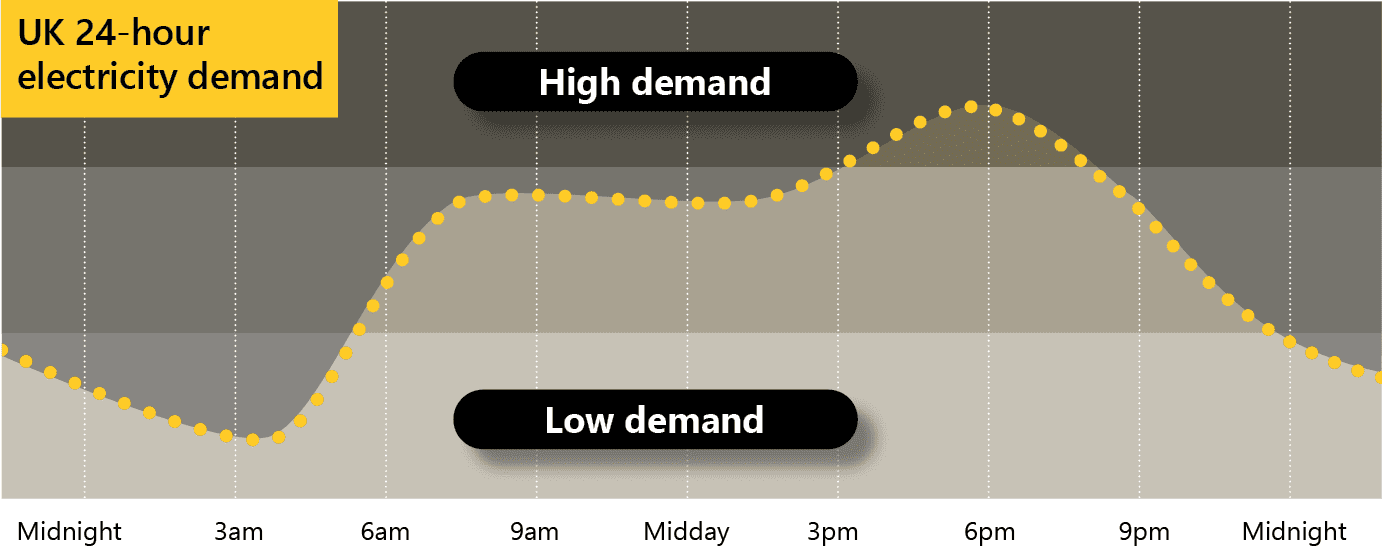Getting smarter with energy
The UK’s energy system is changing.
Back in 2010, almost all of our electricity was generated in power stations by coal, gas or nuclear fuel. Just over ten years later, almost 40% was generated by renewables, mainly solar and wind.
This is great for reducing carbon emissions – essential for tackling climate change. But solar and wind farms are located all around the UK and sometimes too much electricity is being generated in one place, when the demand for it is somewhere else.
We need to become more aware of when we use electricity as well as how much we’re using for this new energy system to work.
The highest demand for electricity is 4-8pm each day, when the majority of UK households are home from school and work, and cooking, watching TV etc. This is called ‘peak time’.

To meet this demand gas-fired power stations are started up. This is expensive and high in carbon emissions. If households can shift some of their home activities out of peak time – for example running washing machines at midday – this will help to cut fuel bills and greenhouse gas emissions.
To reduce peak demand, the National Grid created the Demand Flexibility Service
The DFS rewards people for changing the times when they use the most electricity. Find out how much you could earn by joining in …
More electricity, less fossil fuels
In the years to come, more of our household activities will use electricity. This is because we’ll move away from using fossil fuels for heating and transport, for example with heat pumps and electric cars and ebikes.
This makes balancing the demand and supply of electricity even more crucial. It means we need to shift our electricity use in time to make use of the cheapest, greenest available energy.
Smart energy use
We’re already experts in shifting our electricity use to reduce our costs. We might wait for a sunny day to do our laundry and avoid using a tumble drier, or batch cook food to avoid using our oven every evening. And some households are on Economy 7, a tariff which has a cheap off-peak rate for electricity at night and a higher standard day-rate.
Smart meters can help in this. They provide better information about a home’s consumption of gas and electricity to help households and suppliers manage energy more efficiently. A smart meter monitors the household’s energy use and communicates this information to the energy supplier and to the household via an in-home display or phone app.
If you are on a time-of-use tariff – like Economy 7 – it will show when the cost of the energy changes. This enables you to become more knowledgeable about your energy use. For example, you may decide to put your washing machine on first thing in the morning to take advantage of lower electricity rates.
Smart meters automatically send accurate meter readings to energy suppliers enabling them to bill you for exactly how much energy you have used.
This data also helps the energy industry to predict energy demand for the UK better. If electricity demand exceeds supply, power cuts can occur. Overall, shifting when electricity is used will help balance energy need across the UK and allow more renewable energy to be used.
Smart products and services
Smart products and services help you to automate when and how much energy you use. The simplest types are things that have been around for a long time, like heating timers and mechanical timer plugs.
But now a growing number of devices – washing machines, heating controls and lighting – can be controlled remotely via a smart phone or by voice activation (Alexa, Siri). A home’s smart devices can be integrated via platforms that use smart meter data to make sure you’re using the cheapest energy available.
Many homes now produce their own electricity, usually using solar panels. Power that isn’t used can be stored in the new generation of household battery storage systems so that free electricity generated by solar panels during the day can be used at night.
With time-of-use tariffs, any household with a battery could automatically draw cheap electricity from the grid when renewable generation was high or demand low. Batteries which provide this ‘shifting’ service help to balance the electricity grid, reduce the network costs for all consumers and reduce household energy bills.
Who will benefit from smart appliances?
These options will suit some households but not others. For example, households with young children might need to cook meals at peak times and can’t necessarily shift the time they use their washing machine. Similarly, smart heating controls may not be the best option for those without a smart phone.
Some smart appliances are currently quite costly to buy. However, the right smart products and services could help you to achieve real improvements in your levels of comfort and lower your bills.




